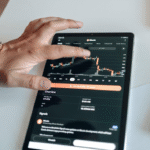
The digital asset market has exploded in popularity in recent years, attracting a new wave of investors eager to capitalize on its transformative potential. However, as the market matures, basic trading strategies are no longer sufficient for maximizing returns and navigating the complexities of this dynamic landscape.
This blog explores the depth of the world of advanced crypto trading, specifically focusing on the integration of derivatives and real-world asset liquidity. We’ll explore how these elements can enhance your trading toolkit, mitigate risks, and unlock new opportunities for profit. So, without further ado, let’s get started:
Understanding Advanced Crypto Trading

Advanced crypto trading goes beyond simply buying and selling cryptocurrencies. It encompasses a wider range of sophisticated strategies and instruments designed to generate returns in various market conditions. Here’s a breakdown of its key characteristics:
- Definition and Scope:Advanced crypto trading utilizes a combination of technical analysis, fundamental analysis, and specialized tools to execute complex trades. This may involve leveraging derivatives, margin trading, algorithmic trading, and high-frequency trading (HFT) strategies.
- Key Differences from Basic Trading Strategies: Basic trading typically involves buying cryptocurrencies at a lower price and selling them at a higher price. In contrast, advanced trading focuses on capitalizing on market inefficiencies, short-term price movements, and hedging strategies to generate profits irrespective of the overall market direction.
The Current State of the Crypto Market
The global crypto market has witnessed phenomenal growth, with the total market capitalization exceeding $2 trillion at its peak in 2021, then facing some sharp decline in 2022 and back again thriving and growing in 2024. A recent report highlights that Bitcoin remains the dominant player, but altcoins and DeFi tokens are experiencing significant growth. Leading exchanges like Coinbase and Binance offer a vast array of crypto assets and trading functionalities, catering to both novice and experienced traders.

Importance of Advanced Strategies
As the crypto market matures, basic buy-and-hold strategies are no longer sufficient as the competition intensifies, and volatility remains a constant factor. Here’s how advanced trading strategies empower investors in this dynamic environment:
1. Enhanced Profitability

Advanced strategies leverage market inefficiencies and short-term opportunities to maximize returns compared to passive investing. Here’s why it’s beneficial:
- Exploiting Market Inefficiencies: Advanced strategies go beyond simply reacting to price movements. By employing technical and fundamental analysis, traders can identify market inefficiencies like short-term price discrepancies or undervalued assets. Capitalizing on these inefficiencies through strategies like arbitrage or mean reversion can generate significant returns.
- Leveraged Gains:Derivatives like futures contracts allow traders to control a larger position in an asset with a smaller capital investment. This leverage can amplify potential profits when market conditions are favorable. However, it’s crucial to understand the increased risk associated with leverage, as losses can also be magnified.
- Short-Term Opportunities:Advanced strategies like scalping and high-frequency trading (HFT) enable traders to profit from short-term price fluctuations within a single trading day. These strategies require sophisticated algorithms and a deep understanding of market dynamics to execute effectively.
2. Increased Control

Advanced strategies offer greater control over investment decisions. Traders can actively manage their portfolios and capitalize on various market conditions, as opposed to passively holding assets in a buy-and-hold approach. Imagine being able to:
- Make Precise Trades:With advanced order types for maximized profits and minimized losses, make precise trades that you can control easily.
- Tailor Your Approach:Based on your risk tolerance and goals, choose your approach, whether it’s aggressive growth or conservative portfolio protection.
- Understand Market Technicalities:Respond swiftly to market shifts with technical analysis, capitalizing on opportunities and minimizing volatility risks.
3. Effective Risk Management
Advanced strategies like hedging with derivatives act as a safety net, protecting your assets during market downturns and mitigating potential losses. Here’s how you can go about it:
- Hedging with Derivatives:Derivatives like options contracts can be used to hedge existing crypto holdings and mitigate downside risk. For example, an investor holding Bitcoin can purchase put options, which grant the right to sell Bitcoin at a specific price by a certain date. This protects against potential losses if the price of Bitcoin falls significantly.
- Portfolio Diversification:Advanced strategies emphasize the importance of portfolio diversification across different asset classes within the crypto market (e.g., Bitcoin, altcoins, DeFi tokens) and potentially even traditional assets. This diversification helps mitigate risk by reducing exposure to any single asset’s volatility.
- Stop-Loss Orders: Advanced traders utilize stop-loss orders to automate risk management. These orders automatically sell an asset when the price reaches a predetermined level, limiting potential losses during sudden market downturns.
4. Adaptability
The crypto market is a whirlwind of innovation. New technologies, regulations, and trends emerge constantly. To survive, you need to adapt. Advanced strategies equip you with the knowledge to:
- Embrace New Technologies:Technology like DeFi protocols to unlock fresh avenues for returns.
- Stay Ahead Of Regulations:By adjusting your strategies to navigate the evolving legal landscape, one can stay ahead of the regulations.
- Refine Your Approach:Based on market trends, employing aggressive tactics in bull markets and defensive strategies during downturns.
Crypto Derivatives
Derivatives are financial contracts whose value is derived from an underlying asset, which in our case, is cryptocurrency. They offer traders a versatile toolbox for managing risk and speculating on price movements.
Common derivative instruments include futures contracts, options contracts, and swaps. Futures contracts lock in a price for buying or selling an asset at a future date. Options contracts grant the right, but not the obligation, to buy or sell an asset at a specific price by a certain time. Swaps involve exchanging cash flows based on the performance of underlying assets.

Benefits of Trading Crypto Derivatives

1. Leverage and Amplified Returns
- Magnify Gains:Crypto derivatives, particularly futures contracts, allow traders to leverage their capital. This means controlling a larger position in an asset with a smaller upfront investment. When market conditions are favorable, leverage can significantly amplify potential returns.
- Short-Selling Opportunities: Unlike traditional asset purchases, some derivatives like futures contracts allow traders to take advantage of falling prices. This enables them to profit even when the market dips, offering an additional avenue for generating returns.
- Increased Capital Efficiency: Derivatives allow traders to participate in the crypto market with less capital compared to buying the underlying asset outright. This frees up capital that can be invested elsewhere in your portfolio.
2. Enhanced Risk Management:
- Hedging with Options:Options contracts offer a valuable tool for hedging existing crypto holdings. By purchasing put options, traders gain the right (but not the obligation) to sell their cryptocurrency at a specific price by a certain date. This acts as insurance against potential price drops, mitigating downside risk.
- Managing Volatility:The inherently volatile nature of the crypto market can be nerve-wracking for investors. Derivatives like options contracts allow for more nuanced risk management strategies. By setting strike prices and expiry dates, traders can tailor their hedging approach to specific risk tolerances.
- Reduced Counterparty Risk:Unlike directly trading with another party, derivatives transactions often involve established exchanges. This reduces counterparty risk, meaning there’s less chance of the other party failing to fulfill their obligations in the contract.
Challenges and Considerations
- Magnified Losses:While leverage can amplify gains, it can also magnify losses. If the market moves against your position, your losses can be significantly higher than the initial capital you invested. Careful risk management and understanding leverage ratios are crucial.
- Regulatory Uncertainty:The regulatory landscape surrounding crypto derivatives is still evolving. This uncertainty can pose challenges for traders, as unclear regulations can impact exchange operations and trading strategies. Staying informed about regulatory developments is essential.
- Complexity for Newcomers:Crypto derivatives can be complex instruments that require a deeper understanding of the financial markets and risk management compared to basic spot trading. New traders are advised to thoroughly educate themselves before venturing into derivatives trading.
Real-World Asset Liquidity

Real-world assets (RWAs) are traditional assets like real estate, commodities (gold, oil), and equities that exist in the physical world. Liquidity refers to the ease with which an asset can be bought or sold without significantly impacting its price.
Traditionally, RWAs have offered stability and diversification to investment portfolios. However, their inherent lack of divisibility and slow transaction times can limit their accessibility for some investors.
This is why blockchain technology has introduced a revolutionary concept: tokenization. This process involves creating digital tokens that represent fractional ownership of a real-world asset. Tokenization unlocks new avenues for investment by:
- Enhancing Liquidity:By dividing RWAs into smaller, tradable tokens, tokenization facilitates easier and faster transactions, improving liquidity for investors.
- Fractional Ownership:Tokenization allows investors to purchase a fraction of a high-value asset like real estate, which would be cost-prohibitive through traditional methods.
Platforms and Technologies

Several platforms are leveraging blockchain technology to revolutionize the way RWAs are traditionally managed, opening doors for advanced crypto trading strategies. These platforms offer a secure and transparent infrastructure for tokenizing RWAs, enabling:
- Fractional Ownership:Blockchain allows for the creation of fungible tokens representing fractional ownership of real-world assets. This makes traditionally high-barrier-to-entry investments like real estate or fine art accessible to a broader investor base.
- Streamlined Transactions:Smart contracts, self-executing code stored on the blockchain, automate various aspects of asset ownership and trading. This eliminates the need for intermediaries, streamlining transaction processes and reducing costs.
- Enhanced Liquidity:Tokenization unlocks new avenues for secondary market trading of RWAs. Investors can easily buy and sell tokenized assets on dedicated platforms, fostering greater liquidity compared to traditional methods.
The increased liquidity of tokenized RWAs creates exciting opportunities for advanced crypto trading strategies:
- Arbitrage Opportunities:Price discrepancies between tokenized RWAs on different platforms can be exploited by employing arbitrage strategies. This involves buying a tokenized asset on a platform where it’s undervalued and quickly selling it on another platform where the price is higher.
- Hedging Strategies:Tokenized RWAs with low correlation to cryptocurrencies can be used to hedge against crypto market volatility. For instance, investing in tokenized real estate during a crypto market downturn can help stabilize your overall portfolio performance.
- Structured Products:Advanced investors can utilize derivatives like options contracts on tokenized RWAs to create structured investment products with tailored risk-reward profiles.
Integrating Derivatives with Real-World Asset Liquidity
The convergence of crypto derivatives and real-world asset (RWA) liquidity presents a new frontier for advanced crypto trading. Here’s how these two seemingly disparate elements can be strategically combined:
The Convergence of Crypto Derivatives and RWAs
Imagine a scenario where you can use derivatives to hedge your investment in a tokenized real estate asset. By employing options contracts, you could mitigate potential losses if the property value dips while still enjoying the upside potential of the real estate market. This synergy unlocks a world of possibilities for investors seeking exposure to both the crypto and traditional asset classes.
Case Studies and Examples
Real-world examples are beginning to emerge. For instance, security token offerings (STOs) tokenize shares of real estate projects, allowing investors to participate through cryptocurrency. Imagine using Bitcoin futures contracts to hedge your investment in an STO representing a commercial building. If the crypto market experiences a downturn, potential losses from Bitcoin could be offset by gains from the appreciating value of the underlying real estate.
Strategies for Integration
Here are practical approaches to integrate derivatives and RWA liquidity:
- Exploiting Price Discrepancies:Tokenized RWAs traded on different platforms can present arbitrage opportunities. By leveraging derivatives like futures contracts, traders can capitalize on price discrepancies. The strategy involves buying a tokenized asset on a platform where it’s undervalued and quickly selling it on another platform where the price is higher to bridge any liquidity gaps between the two platforms, facilitating quicker arbitrage execution.
- Hedging Strategies:Utilize options contracts on major cryptocurrencies to hedge your exposure to tokenized RWAs. This can provide peace of mind during volatile market periods.
- Leveraged Speculation:For experienced traders, leverage offered by derivatives can be used to amplify potential returns on tokenized RWAs that exhibit strong growth prospects.
- Volatility Capitalization:The inherent volatility of the crypto market, while posing risks, can also present short-term trading opportunities. Derivatives like perpetual swaps offer a way to capitalize on these fluctuations without the need for physical settlement of the underlying asset. By employing technical analysis and risk management techniques, traders can utilize derivatives to exploit short-term price movements in tokenized RWAs.
- Tailored Risk-Reward Profiles:Experienced investors can utilize derivatives to create structured investment products tailored to their specific risk tolerance and return expectations. By combining options contracts with tokenized RWAs, investors can design products that offer a range of risk-reward profiles, from conservative income generation to aggressive growth strategies.
Risk Management
The integration of derivatives and real-world asset (RWA) liquidity unlocks a new frontier for crypto trading, but it’s not without its inherent risks. Here’s a breakdown of key risk management strategies to help you mitigate them.
- Thorough Due Diligence: Don’t Take It on Faith
Before committing your capital, conduct meticulous research on the underlying asset of a tokenized RWA. This goes beyond simply understanding the asset class (e.g., real estate, artwork). Deep dive into:
- The Specific Asset:Is it a prime piece of real estate in a growing market or a single share in a struggling company? Understand the quality and potential value of the underlying asset itself.
- The Issuing Company’s Reputation:Who is tokenizing the RWA? Research their track record, experience, and financial stability. Are they a reputable player in the traditional asset class they represent?
- Start Small: Test the Waters Before Diving In
The world of tokenized RWAs and derivatives is still evolving. Begin with smaller investments to gain practical experience. This allows you to:
- Gain Comfort with the Mechanics:Familiarize yourself with the trading platforms, order types, and risk management tools involved in using derivatives to interact with tokenized RWAs.
- Develop Your Trading Skills:Practice your trading strategies in a low-risk environment before deploying larger sums of capital. This allows you to refine your approach and gain confidence in navigating this new asset class.
- Diversification: Spread Your Bets Across the Board
Don’t put all your eggs in one basket. Mitigate risk by maintaining a diversified portfolio across various asset classes. This includes:
- Diversifying Crypto Holdings: Don’t solely focus on a single cryptocurrency. Spread your investments across established coins and potentially explore promising altcoins.
- Incorporating Tokenized RWAs:While tokenized RWAs offer exciting opportunities, they also present unique risks. Limit your exposure to this asset class as a portion of your overall portfolio.
- Considering Traditional Assets:A diversified portfolio might also include traditional assets like stocks, bonds, or even commodities. This broader diversification strategy helps mitigate risk by reducing your reliance on the often-volatile crypto market.
Practical Guide to Mastering Advanced Crypto Trading
Now that we’ve explored the theoretical aspects, let’s understand the practical steps to master advanced crypto trading:
Step 1: Setting Up Your Trading Environment
- Choosing the Right Platforms and Tools: Select reputable crypto exchanges and derivatives platforms that offer a robust suite of trading functionalities and advanced order types. Consider factors like security, liquidity, and fees.
- Security Measures:Implement robust security protocols, including two-factor authentication (2FA) and strong passwords, to safeguard your crypto assets. Consider using hardware wallets for an extra layer of protection.
Step 2: Developing a Trading Strategy
- Market Analysis Techniques:Master technical and fundamental analysis techniques to identify trading opportunities across different market conditions. Utilize charting tools and technical indicators to gauge market sentiment and potential price movements.
- Strategy Formulation and Backtesting:Develop a well-defined trading strategy aligned with your risk tolerance and investment goals. Backtest your strategy on historical data to assess its potential effectiveness before deploying real capital.
Step 3: Execution and Monitoring
- Trade Execution Best Practices:Employ disciplined trade execution practices, including setting clear entry and exit points for your trades. Utilize stop-loss orders to manage risk and limit potential losses during market volatility.
- Monitoring and Adjusting Strategies:Regularly monitor your portfolio performance and market trends. Be prepared to adjust your strategies as market conditions evolve to optimize returns and mitigate risk.
Key Challenges to Watch Out For
- Market Volatility:The inherent volatility of the crypto market remains a constant challenge. Advanced strategies can help mitigate risk, but traders must be prepared for price fluctuations.
- Technological Complexity:Mastering advanced trading tools, derivatives, and the intricacies of tokenized RWAs requires a significant learning curve. Continuous education and staying abreast of technological advancements will be essential.
- Regulatory Uncertainty:The evolving regulatory landscape surrounding crypto derivatives and tokenized RWAs can create uncertainty for investors. Staying informed about regulatory developments is crucial for making informed investment decisions.
Future Trends and Developments
The future of advanced crypto trading is brimming with exciting possibilities:
Emerging Trends in Crypto Trading
- AI and Machine Learning: Artificial intelligence (AI) and machine learning (ML) algorithms are poised to play a more significant role in advanced crypto trading strategies, offering automated trade execution and enhanced risk management capabilities.
- DeFi and its Impact on Derivatives and RWAs: Decentralized Finance (DeFi) protocols are revolutionizing financial services. Expect to see innovative DeFi-based derivatives products and the rise of tokenized RWAs integrated within the DeFi ecosystem.
Regulatory Developments
- Current Regulations and their Implications:Regulatory frameworks surrounding crypto derivatives and tokenized RWAs are still under development. Regulatory clarity will be crucial for fostering further innovation and mainstream adoption.
- Future Regulatory Trends: As the market matures, expect to see clearer regulations governing derivatives and tokenized RWAs, promoting investor protection and market stability.
Conclusion
The world of advanced crypto trading offers a compelling blend of challenge and opportunity. By integrating derivatives and real-world asset tokenization, investors can unlock new avenues for profit while managing risk effectively. Remember, success in this dynamic market requires a combination of knowledge, experience, and a well-defined strategy.
Kenson Investments recognizes the complexities of advanced crypto trading. Our team of experienced professionals possesses a deep understanding of derivatives, real asset tokenization, and the ever-evolving regulatory landscape. As a leading crypto asset investment consultant and cryptocurrency investment consultant, our consultants can guide you through the intricacies of strategic investment solutions and help you develop a personalized approach aligned with your investment goals. We provide expert advice on navigating the world of tokenization of real world assets and leveraging the potential of blockchain technology in your investment strategy while prioritizing the safety of your assets and minimizing associated risks.
Additionally, we explore the growing market of NFT investment platforms for digital assets. These platforms offer opportunities not just for NFT investment platforms for unique tokens but also for NFT investment platforms for long-term growth, enabling you to diversify and strengthen your portfolio.
So, what’s the hold-up? Take the next step towards mastering advanced crypto trading. Contact Kenson Investments today and explore how our cryptocurrency investment solutions can empower you to navigate the exciting frontier of the digital asset market.
Disclaimer: The content provided on this blog is for informational purposes only and should not be construed as financial advice. The information presented herein is based on personal opinions and experiences, and it may not be suitable for your individual financial situation. We strongly recommend consulting with a qualified financial advisor or professional before making any financial decisions. Any actions you take based on the information from this blog are at your own risk.














